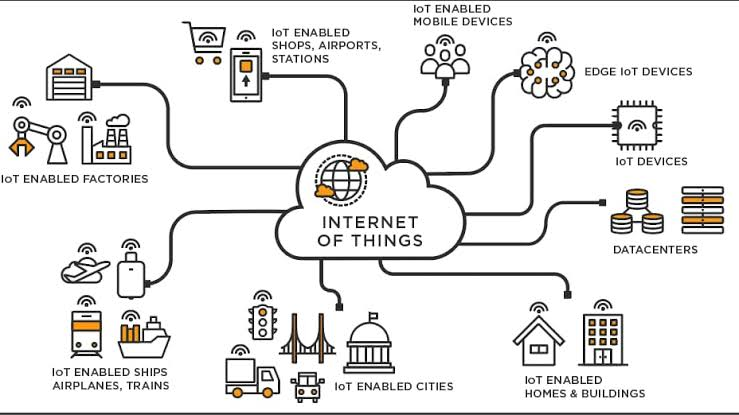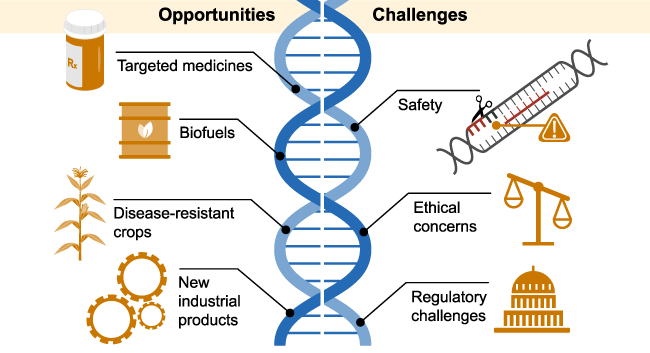Science & Technology
Perspective: Disruptive & Futuristic Technologies
- 28 Dec 2023
- 14 min read
For Prelims: Disruptive Technology, Robotics, Futuristic Technology, Generative AI, Large Language Models (LLMs), FutureSkills PRIME programme, Global Partnership on Artificial Intelligence (GPAI), National AI Portal of India, AI for All, Responsible AI for Youth programme.
For Mains: Significance and Benefits of Disruptive and Futuristic Technologies
What is the Context?
In the contemporary context, there's a dynamic interplay between technological innovation, societal needs, and regulatory frameworks. The pace of change continues to be rapid, and the impact of disruptive and futuristic technologies is felt across diverse sectors, influencing how we live, work, and interact with the world.
What are Disruptive and Futuristic Technologies?
- About:
- Disruptive technologies are innovations that significantly alter or revolutionize existing industries, markets, or societal norms by introducing new approaches, products, or services. These technologies often replace established solutions, creating a substantial impact on the status quo.
- Disruptive technologies typically offer improved efficiency, lower costs, or novel features, challenging traditional business models and reshaping entire sectors.
- Futuristic technologies refer to advanced and cutting-edge innovations that are often conceptualized or in development, with the potential to significantly impact various aspects of human life and society in the future.
- Both these terms are also used interchangeably as futuristic technologies are largely held to be disruptive in nature.
- Disruptive technologies are innovations that significantly alter or revolutionize existing industries, markets, or societal norms by introducing new approaches, products, or services. These technologies often replace established solutions, creating a substantial impact on the status quo.
- Examples:
- Smartphones: Disrupted traditional mobile phones and various consumer electronics by integrating multiple functions into a single device.
- Streaming Services: Disrupted traditional cable and satellite TV by offering on-demand, subscription-based content delivery over the internet.
- Electric Vehicles: Disrupting the automotive industry by challenging the dominance of internal combustion engines with more sustainable electric alternatives.
- 3D Printing: Transforming manufacturing processes by enabling the production of customized, on-demand items with reduced waste.
- Blockchain and Cryptocurrencies: Disrupting traditional financial systems by introducing decentralized and secure methods of digital transactions.
What are the Applications of Disruptive and Futuristic Technologies ?
- Accelerated Technological Advancements:
- Technologies such as artificial intelligence (AI), machine learning, and quantum computing continue to advance rapidly, driving innovation across various industries.
- The convergence of technologies, such as the integration of AI with other fields like robotics, is leading to the development of more powerful and versatile solutions.
- Digital Transformation:
- Organizations across sectors are undergoing digital transformation, leveraging technologies to streamline operations, enhance customer experiences, and gain a competitive edge.
- Cloud computing, edge computing, and Internet of Things (IoT) technologies play pivotal roles in this transformation.
- Remote Work and Collaboration:
- The COVID-19 pandemic has accelerated the adoption of remote work and virtual collaboration tools. Technologies supporting remote communication, video conferencing, and digital collaboration have become essential.
- Health Tech and Biotechnology:
- The healthcare industry is experiencing significant advancements in areas like telemedicine, personalized medicine, genomics, and bioinformatics.
- The pandemic has underscored the importance of health technologies, with increased focus on vaccine development, diagnostic tools, and data-driven healthcare solutions.
- Renewable Energy and Sustainability:
- There's a growing emphasis on sustainable technologies and renewable energy sources to address environmental concerns. Advances in energy storage, smart grids, and electric transportation contribute to a more sustainable future.
- Blockchain and Decentralized Finance (DeFi):
- Blockchain technology continues to evolve, with applications beyond cryptocurrencies. DeFi platforms are reshaping traditional finance by providing decentralized alternatives for banking, lending, and trading.
- Space Exploration and Commercialization:
- The space industry is experiencing a resurgence, with increased interest from both public and private entities. Commercial space travel, satellite constellations, and lunar exploration projects are gaining momentum.
- Nanotechnology:
- Manipulating materials at the nanoscale to create new functionalities, with potential applications in medicine, electronics, and materials science.
- Virtual and Augmented Reality:
- Immersive Technologies such as Virtual Realities (VR) and Augmented Realities (AR) technologies create immersive digital experiences, with applications in gaming, education, healthcare, and virtual collaboration.
What are the Benefits of Disruptive Technology?
- Innovation in Regular Activities: One of the key features of disruptive technology is its ability to offer consumers new and notable benefits across banking, finance, real estate, supply chain etc. When this type of technology enters the marketplace, it changes the entire industry.
- By embracing disruptive technology, individuals and businesses alike can enjoy the benefits that the technology offers to their regular activities.
- Improves and Modifies Techniques: To provide solutions to the problems of the consumers, modern methods need to be adopted.
- Disruptive innovation modifies how a company evaluates its processes and how to adapt according to them, helps in the provision of better services, and brings about a modification in the industry through uses of Chatbots etc.
- Growth of Startup Companies: Disruptive technology provides opportunities for startup companies to gain a significant foothold in existing industries.
- This provides a unique chance for small startups to experience rapid growth and potentially outperform larger, more well-established companies.
- Business Expansion: When an established business willingly embraces disruptive technology, it enjoys prime opportunities for growth within its current industry or within a new industry created by the technology. This results in the economic growth of the country also.
- Companies that can smoothly incorporate disruptive technology in their existing line of products and services can help existing customers transition into using the disruptive technology while also capturing new buyers with their entry into the fresh market.
- Leveraging India’s IT Power: The Indian software industry is well-established, and plans to increase connectivity are well underway as part of ‘Digital India’.
- This would allow for the creation of additive manufacturing facilities in small towns and foster industrial development outside of major cities.
- Environmental Sustainability: Disruptive technologies in renewable energy, energy storage, and sustainable practices contribute to environmental conservation by reducing reliance on non-renewable resources and minimizing ecological impact.
- Personalization and Customization: Many disruptive technologies enable personalized experiences and customized solutions. This includes personalized medicine, tailored consumer products, and targeted advertising based on individual preferences.
What are the Challenges Related to Disruptive & Futuristic Technology?
- Challenging for Developing Countries:
- Developing countries like India are starting from a difficult position, because they are already grappling with the challenges of low human capital, ineffective institutions, and a difficult business environment.
- Trust and Ethical Questions:
- Disruptive Technology per se is not the problem, but there are ethical issues surrounding privacy, ownership and transparency which are related to these technologies that can become a cause of concern.
- Challenges in Adaptability:
- Disruptive innovations take time to prove in the complex market conditions and a significant time period is also consumed in penetrating the market. Disruptive innovations also have to be adaptive to the market environment.
- Untested & Time Consuming:
- New technology is typically untested and unrefined during its early stages and development can continue for years.
- Any innovative idea depending upon its utility and ability to meet the market needs has to undergo a gestation period. It takes a significant period for any innovative idea or a product or service to get established in the market.
- New technology is typically untested and unrefined during its early stages and development can continue for years.
- Redundancy of Prevalent Old Technology:
- New ideas or business models have a tendency to disrupt the existing and established ideas/products/services/business models and this creates fierce competition in the market.
- This is very challenging for any new idea as the existing and established business may take any course to prevent them from being thrown out of the market.
- New ideas or business models have a tendency to disrupt the existing and established ideas/products/services/business models and this creates fierce competition in the market.
- Cybersecurity Challenges:
- As technologies advance, the importance of robust cybersecurity measures grows. The increasing frequency and sophistication of cyber threats underscore the need for ongoing developments in cybersecurity technologies.
- Global Collaboration and Competition:
- The development and deployment of disruptive and futuristic technologies involve global collaboration and competition. Countries and companies are vying for leadership in key technological domains such as the ongoing rivalry between the US and China.
What Can be the Way Forward?
- Favorable Environment:
- A policy framework for the next generation of technology and innovation should focus on creating an enabling environment for disruptive technologies to positively impact the economy, society, and environment, and reduce inequalities.
- Holistic Approach:
- Whole-of-economy or most-of-society approach should be followed, technology alone will not guarantee success.
- Policymakers must also account for local contexts and conditions so that they can create social, political and economic ecosystems in which technology creates jobs and drives inclusive growth.
- Promotion of R&D Sector:
- There is a need to encourage the formation of product design centers so that the products are built to suit the Indian environment and consumers and also inclusive ICT infrastructure.
- Need for Government Support:
- There is a need for government support to provide incentives for distributed manufacturing in smaller towns, and for the IT industry to work on creating platforms and marketplaces that connect consumer demands, product designers and manufacturers in a seamless way.
- International Cooperation:
- Given that various governments have only recently established these types of disruptive technologies like AI, and in some cases are still formulating them, international cooperation is still very much a work in progress in terms of setting the standards at the multilateral level.
Conclusion
This type of technology, if introduced, gives loads of notable benefits to both consumers as well as businesses. An entire industry is changed due to innovative technology, and that too in a positive manner. Thus, if the technology is embraced and used efficiently, it can offer immense innovative benefits both to the consumers of the industry as well as the producers.
UPSC Civil Services Examination, Previous Year Questions (PYQs)
Prelims
Q. With the present state of development, Artificial Intelligence can effectively do which of the following? (2020)
- Bring down electricity consumption in industrial units
- Create meaningful short stories and songs
- Disease diagnosis
- Text-to-Speech Conversion
- Wireless transmission of electrical energy
Select the correct answer using the code given below:
(A) 1, 2, 3 and 5 only
(B) 1, 3 and 4 only
(C) 2, 4 and 5 only
(D) 1, 2, 3, 4 and 5
Ans: (B)
Q. With reference to “Blockchain Technology”, consider the following statements: (2020)
- It is a public ledger that everyone can inspect, but which no single user controls.
- The structure and design of blockchain is such that all the data in it are about cryptocurrency only.
- Applications that depend on basic features of blockchain can be developed without anybody’s permission.
Which of the statements given above is/are correct?
(A) 1 only
(B) 1 and 2 only
(C) 2 only
(D) 1 and 3 only
Ans: (D)






